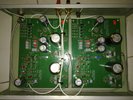The dimensions of the board that I had made are 4x3 inches, but I suspect that you are asking for gain, THD/noise, frequency response, RIAA response, THD etc.
I have not done any serious measurements, but the praise shown for the CNC in this thread gives a clue about real life performance. The gain is easily calculated (at 1kHz), and is shown in my previous post. The frequency response depends on the opamps, and the RIAA curve is very decent thanks to a tried and true passive RIAA filter.
Rod Elliot's P06 RIAA stage uses an active low frequency filter and a passive high frequency filter. It is otherwise quite similar, being a two gain-stage opamp circuit. He is providing some performance numbers in his article.
Apart from that, it all depends on the components you choose, the input impedance/capacitance, enclosure/shielding, interconnects, pickup, turntable etc.








